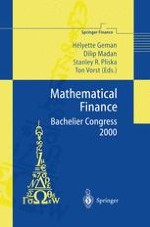2002 | Buch
Mathematical Finance — Bachelier Congress 2000
Selected Papers from the First World Congress of the Bachelier Finance Society, Paris, June 29–July 1, 2000
herausgegeben von: Hélyette Geman, Dilip Madan, Stanley R. Pliska, Ton Vorst
Verlag: Springer Berlin Heidelberg
Buchreihe : Springer Finance
Enthalten in: Professional Book Archive
